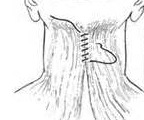The neck is one of the primary reasons that patients present for some form of faciial rejuvenation. It is not rare that such aging patients only wants a ‘necklift’ and not a fuller ‘facelift’, even though they rarely understand the difference between these two procedures or facial rejuvenation concepts. There are a wide variety of neck remodeling procedures that are currently available with vary in their degree of invasiveness and extent of the surgery.

A submental incision with open access to the neck was used 93% of the time in his ten year series. The incision was almost always placed directly in the submental skin crease. Electrocautery was used for some of the neck skin flap elevation and all of the defatting and subplatysmal work. Hematomas and seromas were very rare (1% or less) and drains were used occasionally up to a week after surgery. Conversely injury to the marginal mandibular nerve was not rare and occurred to some degree in almost 10% of the cases. It usually resolved by four months after surgery but in some cases took longer.
The management of loose neck skin was managed primarily by lateral excision in the occipital region in most cases. The postauricular incision is extended high up behind the top of the ear and well behind the occipital hairline after being trimmed. There are still some cases in which no skin is removed but this requires a patient with good skin tone with little means to camouflage a scar behind the ear.
Subplatysmal fat extraction was performed in most patients in this series. (80%) The anterior digastric muscles are rarely now sutured or manipulated. If a submandibular gland bulge is present, the superficial lobe of the gland is removed. A corset plastysmaplasty was performed in 90% of the patients running a suture from the chin down to the cricoid and then back up. (2-0 PDS) A ‘tuckster suture’ is also used running from the fascia behind the ear, towards the midline and then turns back to the ear where it is tied. Its purpose is to help contour the submandibular area.
Many plastic surgeons feel that the best result of any neck lift comes when it is part of an overall facelift to get the best neck and jawline contouring results. The neck lift techniques described and shown in this paper contradict this belief. Clearly, patient education is key to clarify what an independently done neck lift can and can not do as it relates to aging issues above the jawline.
This paper provides a long-term review and technical pearls based on the original ‘corset plastymaplasty’ which was published years ago. The procedure remains somewhat ‘complex’ and time consuming to do but when carefully applied it produces very long-lasting and satisfying results.
Dr. Barry Eppley
Indianapolis, Indiana


